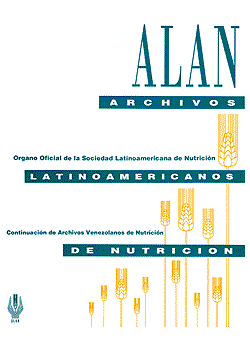Consumo de frutas, verduras y presión arterial: un estudio poblacional
Palabras clave:
Presión Arteria, Frutas, Verduras, Blood Pressure, Fruits, VegetablesResumen
Se ha descrito que consumir frutas y verduras disminuye la presión arterial. Sin embargo, no está clara la magnitud del efecto según la cantidad consumida. El objetivo de este estudio fue analizar la asociación entre consumo de frutas y verduras, y presión arterial. Se realizó un estudio transversal en una muestra aleatoria de 777 adultos entre 32 y 38 años de la Región de Valparaíso, Chile. Se midió presión arterial sistólica (PAS) y diastólica (PAD), y se aplicó una encuesta de tendencia de consumo cuantificada del último mes. La ingesta de frutas y verduras se dividió en tres grupos: menor a 200 g, 200 a 400 g, mayor a 400 g. Para el análisis se utilizaron modelos de regresión lineal múltiple ajustados por sexo, IMC, actividad física, nivel socioeconómico, tabaquismo e ingesta de sodio. Se observó que a medida que aumenta la ingesta de frutas y verduras disminuye la presión arterial sistólica(β=-3,37; IC 95%: -6,45 a -0,29; en consumo entre 200 y 400 g) (β=-4,02; IC 95%: -7,06 a -0,98; en consumo mayor a 400 g), mientras que en la presión diastólica solamente se ve el efecto en los que cumplen la recomendación de la OMS de consumir más de 400 g al día (β-2,87; IC=-5,17 a -0,57). Se concluye que consumir frutas y verduras en cantidades mayores a 400 g, tiene un efecto protector en el aumento de la presión arterial tanto sistólica como diastólica.
Consuming fruits and vegetables is known to lower blood pressure. However, it is unclear how much should be consumed in order to achieve this effect. The aim of this study was to analyze the association between fruit and vegetable consumption and blood pressure. A cross-sectional study was conducted among a random sample of 777 adults between the ages of 32 and 38 from the Region of Valparaiso, Chile. Systolic blood pressure (SBP) and diastolic blood pressure (DBP) were measured, and a survey was carried out to quantify consumption trends over the past month. The fruit and vegetable intake was divided into three groups: less than 200 g, 200-400 g, and more than 400 g. In the analysis, multiple linear regression models were used and were adjusted for sex, BMI, physical activity, socioeconomic status, smoking, and sodium intake. It was observed that increasing intake of fruits and vegetables lowers the systolic blood pressure (β = -3.37 , 95% CI : -6.45 to -0.29; for consumption between 200 and 400 g ) (β =-4.02 , 95% CI: -7.06 to -0.98; for consumption great than 400 g), while an effect on diastolic pressure is only seen in those who meet the WHO recommendation of consuming more than 400 g per day (β -2,87, CI = -5.17 to -0.57). In conclusion, consuming fruits and vegetables in amounts larger than 400 g per day, provides a protective effect against increases in both systolic and diastolic blood pressure.
Descargas
Descargas
Cómo citar
Número
Sección
Licencia
Usted es libre de:
Compartir — copiar y redistribuir el material en cualquier medio o formato
Adaptar — remezclar, transformar y construir a partir del material
La licenciante no puede revocar estas libertades en tanto usted siga los términos de la licencia
Bajo los siguientes términos:
Atribución — Usted debe dar crédito de manera adecuada, brindar un enlace a la licencia, e indicar si se han realizado cambios. Puede hacerlo en cualquier forma razonable, pero no de forma tal que sugiera que usted o su uso tienen el apoyo de la licenciante.
NoComercial — Usted no puede hacer uso del material con propósitos comerciales.
No hay restricciones adicionales — No puede aplicar términos legales ni medidas tecnológicas que restrinjan legalmente a otras a hacer cualquier uso permitido por la licencia.




